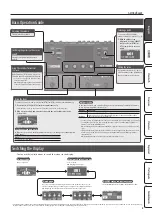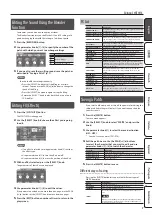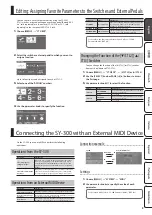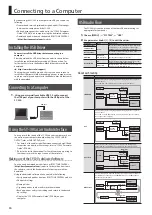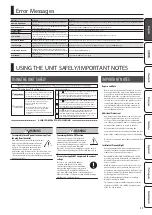
Getting Ready
3
Switching the Display
You can use the [
K
] [
J
] buttons to switch the screens in the display.
Play (patch select) screen
Select a patch.
&
ON/OFF status indication screen
Shows the ON/OFF states of OSC1–OSC3 and FX1–FX4.
Tuner screen
Tune your guitar.
Quick page
Here you can assign the desired parameters to the parameter knobs [1]–[4].
There are two Quick pages, allowing you to assign a total of eight parameters.
“Assigning Favorite Parameters to Parameter Knobs [1]–[4]” (p. 8)
* The explanations in this manual include illustrations that depict what should typically be shown by the display. Note, however, that your unit may incorporate a newer, enhanced version of the system (e.g.,
includes newer sounds), so what you actually see in the display may not always match what appears in the manual.
Basic Operation Guide
Selecting a patch
You can recall the SY-300’s
various sounds as “patches” (p. 4).
1.
With the play screen
displayed, use the [SELECT]
knob or the [
I
/CTL2] [
H
/
CTL3] switches to select a
patch.
Editing the value
Use parameter knobs [1]–[4] to
edit the values of the parameters
that are shown in the screen.
Using the switches for control
([CTL] switch)
By default, the [CTL] switch controls a
function that’s assigned by each patch.
* You are free to assign the pedals to other
functions if you like.
“Editing: Assigning Favorite Parameters
to the Switches and External Pedals” (p. 9)
Switching the guitar synthesizer on
and off
Switches the guitar synthesizer on
and off.
Adjusting the volume
This adjusts the volume.
Using the Tuner
To enter the tuner screen, press the [
I
/CTL2] [
H
/CTL3] switches simultaneously.
1.
Press the [
I
/CTL2] [
H
/CTL3] switches simultaneously.
* From the play screen (p. 4) you can also enter the tuner screen by pressing [
K
].
2.
Play an open string, and tune it so that only the center indicator in the
screen is lit.
Setting the standard pitch
In Tuner mode, you can turn the parameter knob [1] to change the standard pitch
of the tuner.
Pitch
435–445 Hz (default: 440 Hz)
Output setting
In the tuner screen, you can also change the output setting for when the tuner is
in use by turning parameter knob [4].
OUTPUT
Explanation
MUTE
Sound will not be output while tuning.
BYPASS
While tuning, the sound of the guitar being input to the SY-300 will be output
without change. All effects will be off.
* So that you don’t accidentally enter the tuner screen while you’re performing, you can make
a setting that prevents you from entering the tuner screen even if the [
I
/CTL2] [
H
/CTL3]
switches are pressed simultaneously.
“Preventing Inadvertent Operation During Performance (Tuner Lock, Select Knob Lock)”
* If either the [
I
/CTL2] or the [
H
/CTL3] switch has been changed to the CTL function, it is not
possible to enter the tuner screen even by pressing the [
I
/CTL2] and [
H
/CTL3] switches
simultaneously.
“Changing the Function of the [I/CTL2] [H/CTL3] Switches” (p. 9)



